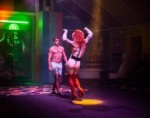
Photo: Carley Schaffer
Lost in a New Wonderland
by Whitney Weinstein
“We’re the new kid in town!” said Artistic Director Christopher Fleming as he welcomed the audience with beamish gratitude. It seemed appropriate that his relatively new company, BalletFleming, produced a show about exploration, new friends, and life’s enlightening journeys.
Alice in Wonderland was a contemporary twist on a classic story and traditional ballet technique without being exaggeratedly experimental. Anticipating its third season, BalletFleming unleashed an original production of Lewis Carroll’s Alice in Wonderland. The company cavorted alongside youth dancers from the Tricia Sloan Dance School and the Philadelphia area. With an appetite “to educate, entertain, and feed the soul,” Philly-based BalletFleming is curious about combining storytelling, expression through music, and elements of musical theatre into a repertory that appeals to audiences young and mature.
The assemblage listened to a recorded overture before meeting Alice, danced by Adriana de Svastich, who fit the storybook portrayal: blond, wearing a blue dress with a white apron, frolicking in the green grass by a tree. After a lively duet of springs and hops, the White Rabbit (Shannan McCormick) bounced into scenes just long enough to dramatically check his pocket watch and stretch his hand out to Alice, expressing concern. Alice followed him down a hole, depicted by the projected image of a downward spiral into darkness. Figures covered in black lifted and twirled Alice in the air until she plopped into the “slithy toves” (as Carroll might say). Her delicate fingers seemed to lift her to standing, and she hurriedly continued her White Rabbit chase. As the characters bustled through the tale, I sensed my captivation growing. I lost myself in Wonderland.
Alice was also lost, but soon discovered new company. When the Caterpillar exhaled a burst of imaginary smoke behind Alice, it rippled her body into a spell of dizziness. She leaned backwards and the Caterpillar slid her, feet first, on a downstage diagonal. Her expression rested in overwhelming confusion. From here, Alice’s Wonderland adventures continued in burbled befuddlement.
Almost every dancer demonstrated strong character commitment, supporting the show’s overarching success. Even when they weren’t center stage, characters animated the background as they conversed over tea, plotted a trick, or intently watched other dancers. Throughout the show barely anyone missed a beat—literally. Each leap, jump, and gesture was perfectly timed, synchronized, and executed. I was astonished to see such a professional standard from a company so fresh. Fleming certainly chose dancers with well-developed abilities.
Equally impressive were the costumes designed by Gina-marie Battista. Each one was remarkably specific: the White Rabbit wore a white leotard with elaborate face makeup, white suit coat, vest, gloves, and top hat with ears; the playing card characters were sandwiched between opposing sides of heart cards, with identical underclothes for uniformity; the hookah-smoking Caterpillar wore a bluish-purple, head-covering unitard with stuffed gloves stitched to his sides. Rich colors illustrated every scene, while craftsmanship and detail propelled me further from reality. Not a single mismatched ensemble or loose stitch existed to remind me that this realm was imaginary.
The Caterpillar, danced by Nick Peregrino, showed an immense amount of control in his slow side bends and wide leans over forced arch, which contrasted with his later role as the goofy, mind-changing Mad Hatter. A Mad Tea Party was the most fun of all the scenes. Tweetle Dee and Tweetle Dum (Hallie Berger and Christina Monteleone), March Hare, (Matthew Stern), and Tea Mouse (tiny Analisa Varricchio), were led by the Hatter, who flailed with clarity. Though his temperament mimicked madness, each directional shift was portrayed with unswerving intention. As they set the table, the four dancers comically rearranged their seating order by crawling under, sliding over, and turning along the perimeter of the table. The audience chuckled and snickered.
After traveling home, Alice was awoken by her School Teacher (Alyson Pray), who also appeared as the Queen of Hearts. The last character seen in the show, Teacher sauntered offstage, discreetly revealing part of her Queen of Heart’s costume. From the time Alice stepped foot into the fantastical place, I sat in “uffish” thought and “gimbled in the wabe.” That night, I carried a piece of Wonderland into the real world with me, anxious to see what adventures BalletFleming will take me on next.
Alice in Wonderland, BalletFleming, The Painted Bride, April 18-19. Scottish Rite Theater, May 11.
By Whitney Weinstein
June 12, 2013







.png)


